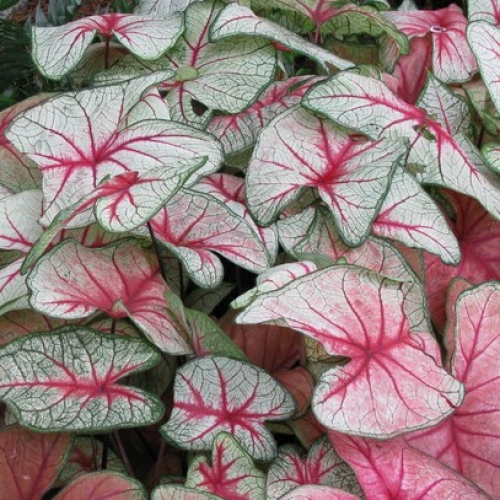Indoor plants Caladium

Description
Special Features of Caladium
Caladium (synonyms Aphyllarum or Phyllotaenium) is a genus containing about a dozen of stemless plants in the aroid family Araceae. Caladiums grow as understorey plants in rainforests across Americas from Florida to Brazil.
These jiucy perennial herbs have cone-like tubers rather than roots and simple single-bladed leaves that are classified as "saggitate" (arrowhead-like). However, Caladiums are commonly called Angel Wings, Elephant Ear, or Heart of Jesus because their 30-50 centimetre leaves are shaped (and often coloured) like a card suit symbol of Hearts rather than an arrowhead.
Sap of all parts of the plants belonging to the genus may cause allergy and is considered poisonous. Nevertheless, an edible Caladium exists (Caladium esculentum). In South America, it is cultivated as a crop for its starch-rich tubers.
However, Caladiums are mostly cultivated as ornamental plants for decoration of gardens, various flower beds (mixed borders, front gardens, parterres, or border beds) and interior landscaping. The most famous, perhaps, is Caladium bicolour, also referred to as Caladium picturatum, Caladium marmoratum, and Caladium hortulanum. Other species worth mentioning are Caladium humboldtii, Caladium lindenii, and Caladium schomburgkii. They have been successfully domesticated and selected, thus marking the beginning of a wide range of cultivars with paperlike-thin leaf blades variously shaped (arrowhead-like or spear-shaped) and coloured (white, red, purple, pink, or mixed). They look great both as singles and grouped with solid-coloured foliage plants.
Caladium is often confused with Cladium because of the similar pronounciation. You should know that Cladium is a genus of herbaceous plants of the sedge family Cyperaceae and combines 4 species Cladium californicum, Cladium jamaicense, Cladium mariscoides, Cladium mariscus, as well as subspecies Cladium chinense, Cladium nipponense, Cladium procerum native to Australia etc. All of Cladiums perfectly match their common name of Saw Grass.
The fruits are berries on a panicle produced from a typical alarum-type spadex. The inflorescences (despite white spathes) and fruits are of no interest.
Caladium bicolour grows to 20-40 centimetres tall in indoor cultivation. The leaves are 10-17 centimetres long and 10-30 centimetres wide. The colouring ranges from green with red and white blotches to red with green margins and white pigmentation. The
Secrets to Successfully Growing Caladium
Though Caladium prefers well-lit places in the eastern- and western-facing windows (in the south-exposure window, protect it from direct sunlight), it will grow in filtered light or even in partial shade (but not in full shade).
Water carefully:
1) After watering, the soil should be moist but not soggy. Overwatering will cause tuber rot.
2) Avoid water getting on the delicate leaves. Brown spots similar to a bruise on the child's tender skin may appear.
The plant likes high air humidity (at least 70%). Spray the air around the leaves rather than the leaves. You may put the pot in a container with wet moss, sand, or expanded clay.
Carefully control humidity during tuber germination after the resting period, if you keep your Caladium in the windowsill and the heating is still on. Cover it with glass or plastic and after the first leaf appears, increase humidity a little.
The plant loves high temperatures and is very sensitive to cold, which is closely linked to its origin. Watch the temperature in the room. The best temperatures are 25-30 ° C in the summer and 18-20 ° C in the winter.
In the autumn around late September, Caladium starts the resting period that is very long and lasts for almost half a year. The leaves gradually wilt and drop. After all of above-ground part withers away, place the pot in a dark (but not cold!) place. Regularly check the condition of the tuber and water the soil. Some experts recommend keeping tubers in dry sand without watering. Others recommend lifting the tuber and keeping it wrapped in a cloth at a temperature of 13-16 ° C.
After dormancy in late February or early March, plant the tuber in fresh soil consisting of equal-part leaf mold, peat soil, humus, and sand (at 1:1:1:1). You can use a mixture of peat moss, peat, sand, vermiculite, and charcoal. The simplest way is to use loam, leaf mold, and sand at 2:4:1. It is essential that the soil should be lightweight, airy, and slightly acidic (pH = 5.0-6.0).
Feed Caladium every two weeks with foliage plant fertilizer.
Propagation:
- By division of tubers (each separated part is to have an "eye", i.e. the growth point)
- By bulblets
- By seed (rarely).
Caladium it does not need pruning.
Potential Problems
Caladium is sensitive to cold water and drafts.
If air humidity is too low, new leaves grow distorted and leaf edges dry up.
If the place is too dark, the leaves will grow slowly and / or small with a pronounced loss of turgor pressure. (Turgor pressure is the pressure exerted on the plant cell wall by water passing into the cell.)
The insect pests that can threaten Caladium are spider mites and aphids.







 83 758
83 758







